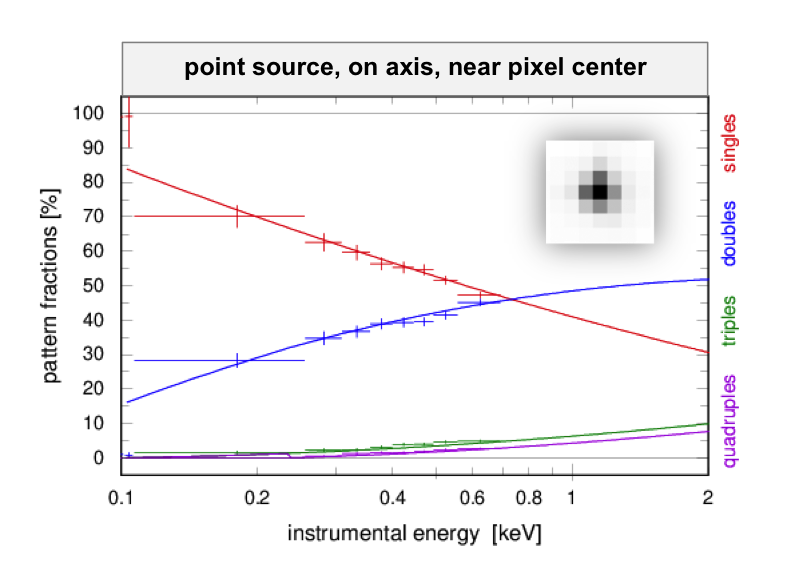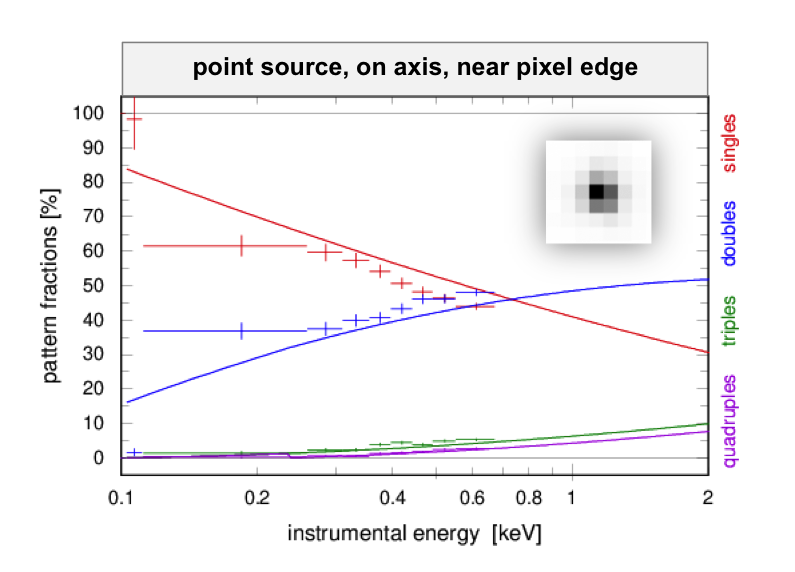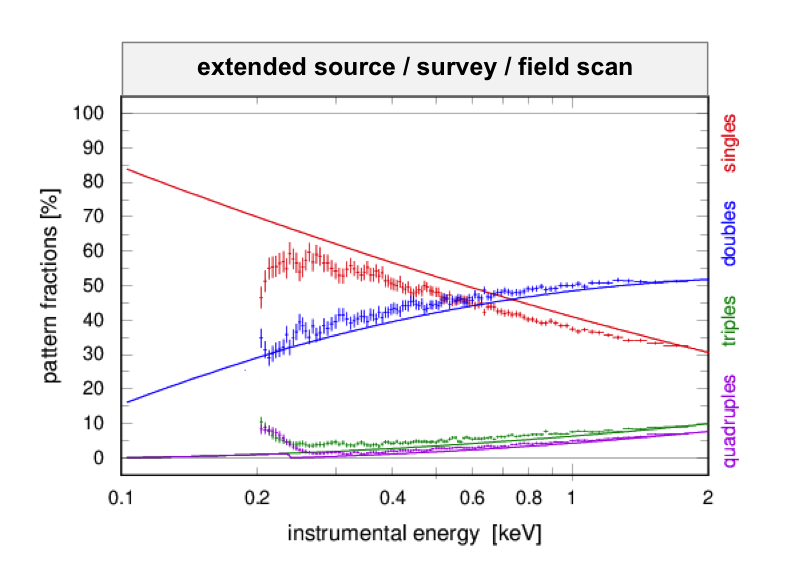Pattern Fractions
The charge cloud released by the absorption of an X-ray photon is not necessarily confined to one single pixel but may extend over up to four pixels. To reconstruct the energy of the incident photon, it is necessary to collect, correct, and combine all the measured charge components. This process is hampered by the presence of noise, i.e., a charge which is generated by the detector itself and which is characterized by a steep rise towards lower PHA values. It is thus necessary to consider only pixels in the charge collection process which contain signal above a certain threshold. Telemetry restrictions may make it necessary to increase this threshold in order to suppress the transmission of pixels which are likely to contain mainly noise.
The introduction of a low energy threshold has an important consequence: it makes pixels which contain charge below this threshold invisible to us. This implies that small charge components may get lost in the charge collection process, leading to low energy tails and degrading the spectral resolution. And it may change the pattern size, i.e., the number of pixels which we attribute to the extent of the charge cloud.
The pattern size is an important quantity for spectroscopy because there is some uncertainty in the determination of the charge of a pixel; if the charge is distributed over several pixels, then these uncertainties add up. This effect causes a degradation of the spectroscopic quality with increasing pattern size (with the possible exception of 4-pixel patterns in the case of a high threshold, because there the charge collection is more complete than for smaller patterns). Thus, if the statistical quality is sufficiently high, it makes sense to concentrate on a detailed spectroscopic analysis on single-pixel events. Another reason for using singles is that they cover lower energies than larger patterns, because the charge needs to exceed the low energy threshold only once.
For a fixed low energy threshold, the relative number of pattern types (singles, doubles, triples, and quadruples) depends on the energy of the incident X-ray photon: a photon with higher energy releases more charge, which implies that its charge cloud is cut at a relatively lower value by the low energy threshold and thus appears larger (the actual extent of the charge cloud may also vary with energy, but this would be a minor effect here). For pattern resolved spectroscopy it is important to consider the energy dependence of the relative number of pattern types, which we call pattern fractions here. The pattern fractions depend not only on the photon energy, but also on the low energy threshold, because an increase of the threshold makes patterns smaller at a given energy.
In the current calibration, the pattern fractions are considered in the normalization of the pattern-specific RMFs (more details here). Although they are, strictly speaking, an ARF component, this was done because no other ARF component is related to the size of the pixel pattern and because the pattern-specific RMFs contain already the pattern-specific energy resolution. After launch, it was necessary to adjust the thresholds somewhat, which has influenced the pattern fractions. In the currently available RMFs this change has not yet been taken into account.
When point sources are observed near on-axis, another effect needs to be considered: the optics concentrate a major fraction of the X-rays into an area which is smaller than the pixel size. This, together with the very stable pointing of the satellite, cause the pattern fractions to depend on the subpixel position of the PSF core, which may vary between the TMs and is likely to vary between repeated observations of the same object.
The current situation is illustrated in Figures 1 and 2 (below) for a point source observed on axis, when located near a pixel centre or near a pixel edge, and in Figure 3 (below) for an extended source or a source observed during the survey or field scan.

Figure 1.

Figure 2.

Figure 3.
Please note that the description above is somewhat simplified. In order to save telemetry, the concept of two thresholds is applied onboard (see Processing Modes). The relevant threshold for the pattern fractions is the secondary threshold.